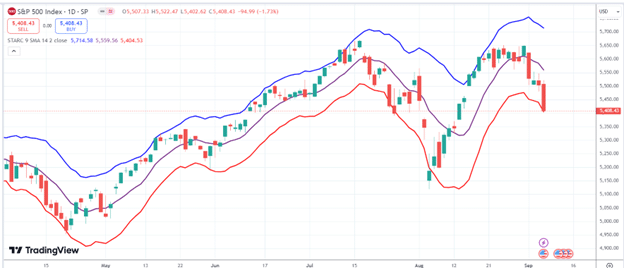STARC is short for Stoller Average Range Channel.
One can plot this technical indicator on top of a stock chart.
Manning Stoller, hence its name, developed the STARC technical indicator.
Contents
Example Of Stoller Average Range Channel The Mathematical Formula For Stoller Average Range Channel Uses Of The Stoller Average Range Channel Final ThoughtsThis technical analysis tool is of the type where it puts an envelope around the stock’s average price.
The stock’s average price is calculated by a simple moving average, typically of a 5 to 10-period moving average.
The upper band and lower band of the envelope are determined by some multiple of the ATR away from this moving average.
This multiplier is typically between 1 to 2.
ATR is the Average True Range value of the price over 14 days – typically 14 days, but it can be adjusted.
Example Of Stoller Average Range Channel
Maybe it will make more sense when you see it plotted on a candlestick chart:

Free Earnings Season Mastery eBook
This is the Stoller Average Range Channel plotted on a chart of SPX (the S&P 500 index) using TradingView.
As plotted in the above screenshot, the indicator setting that was used is a 9-period simple moving average with a 14-period ATR and a multiplier of 2.
That means the upper blue band is 2 ATRs away from the moving average.
The lower red band is 2 ATRs away from the moving average.
The middle line is the 9-period moving average.
We are unsure if these are the settings Stoller used or intended.
There is no consensus on the default settings for this indicator.
However, these settings appear to envelop the price very well.
While the Stoller Average Range Channel is not a standard indicator on TradingView, it can be found in the community scripts.
Mathematically, the indicator would not be difficult to program in TradingView.
So, it is doubtful that there would be an error in the community script.
Nevertheless, spot-checking the values to see if they make sense would be a good idea.
One can manually calculate some numbers using the below formula.
The Mathematical Formula For Stoller Average Range Channel
The formula for determining the upper and lower bands of the Stoller Average Range Channel is:
Upper Band = SMA + (K × ATR)
Lower Band = SMA − (K × ATR)
Where:
K is the multiplier (typically from 1 to 2)
SMA is the simple moving average
ATR is the average true range
Uses Of The Stoller Average Range Channel
Some traders like to use this indicator to identify potential overbought or oversold conditions.
Some use it to determine entry and exit points in their particular strategy.
Final Thoughts
The Stoller Average Range Channel indicator does not appear to be heavily used by many investors.
It is not even available in some charting software.
Retail traders find the Bollinger Bands and the Keltner Channels to be in more mainstream usage, and they serve very similar purposes in technical analysis.
However, a small group of investors find utility in using the Stoller Average Range Channel.
We hope you enjoyed this article about the STARC technical indicator.
If you have any questions, please send an email or leave a comment below.
Trade safe!
Disclaimer: The information above is for educational purposes only and should not be treated as investment advice. The strategy presented would not be suitable for investors who are not familiar with exchange traded options. Any readers interested in this strategy should do their own research and seek advice from a licensed financial adviser.













 Bengali (Bangladesh) ·
Bengali (Bangladesh) ·  English (United States) ·
English (United States) ·